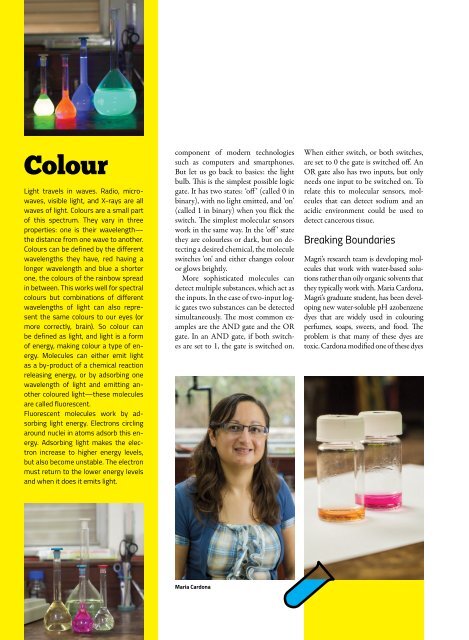You also want an ePaper? Increase the reach of your titles
YUMPU automatically turns print PDFs into web optimized ePapers that Google loves.
Feature<br />
Colour<br />
Light travels in waves. Radio, microwaves,<br />
visible light, and X-rays are all<br />
waves of light. Colours are a small part<br />
of this spectrum. They vary in three<br />
properties: one is their wavelength—<br />
the distance from one wave to another.<br />
Colours can be defined by the different<br />
wavelengths they have, red having a<br />
longer wavelength and blue a shorter<br />
one, the colours of the rainbow spread<br />
in between. This works well for spectral<br />
colours but combinations of different<br />
wavelengths of light can also represent<br />
the same colours to our eyes (or<br />
more correctly, brain). So colour can<br />
be defined as light, and light is a form<br />
of energy, making colour a type of energy.<br />
Molecules can either emit light<br />
as a by-product of a chemical reaction<br />
releasing energy, or by adsorbing one<br />
wavelength of light and emitting another<br />
coloured light—these molecules<br />
are called fluorescent.<br />
Fluorescent molecules work by adsorbing<br />
light energy. Electrons circling<br />
around nuclei in atoms adsorb this energy.<br />
Adsorbing light makes the electron<br />
increase to higher energy levels,<br />
but also become unstable. The electron<br />
must return to the lower energy levels<br />
and when it does it emits light.<br />
component of modern technologies<br />
such as computers and smartphones.<br />
But let us go back to basics: the light<br />
bulb. This is the simplest possible logic<br />
gate. It has two states: ‘off ’ (called 0 in<br />
binary), with no light emitted, and ‘on’<br />
(called 1 in binary) when you flick the<br />
switch. The simplest molecular sensors<br />
work in the same way. In the ‘off ’ state<br />
they are colourless or dark, but on detecting<br />
a desired chemical, the molecule<br />
switches 'on' and either changes colour<br />
or glows brightly.<br />
More sophisticated molecules can<br />
detect multiple substances, which act as<br />
the inputs. In the case of two-input logic<br />
gates two substances can be detected<br />
simultaneously. The most common examples<br />
are the AND gate and the OR<br />
gate. In an AND gate, if both switches<br />
are set to 1, the gate is switched on.<br />
When either switch, or both switches,<br />
are set to 0 the gate is switched off. An<br />
OR gate also has two inputs, but only<br />
needs one input to be switched on. To<br />
relate this to molecular sensors, molecules<br />
that can detect sodium and an<br />
acidic environment could be used to<br />
detect cancerous tissue.<br />
Breaking Boundaries<br />
Magri’s research team is developing molecules<br />
that work with water-based solutions<br />
rather than oily organic solvents that<br />
they typically work with. Maria Cardona,<br />
Magri’s graduate student, has been developing<br />
new water-soluble pH azobenzene<br />
dyes that are widely used in colouring<br />
perfumes, soaps, sweets, and food. The<br />
problem is that many of these dyes are<br />
toxic. Cardona modified one of these dyes<br />
Maria Cardona<br />
44


